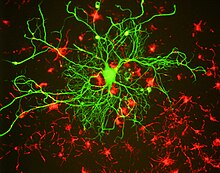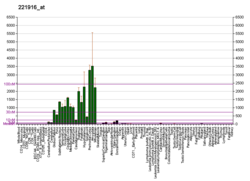Neurofilament light polypeptide, also known as neurofilament light chain, abbreviated to NF-L or Nfl and with the HGNC name NEFL is a member of the intermediate filament protein family. This protein family consists of over 50 human proteins divided into 5 major classes, the Class I and II keratins, Class III vimentin, GFAP, desmin and the others, the Class IV neurofilaments and the Class V nuclear lamins. There are four major neurofilament subunits, NF-L, NF-M, NF-H and α-internexin. These form heteropolymers which assemble to produce 10nm neurofilaments which are only expressed in neurons where they are major structural proteins, particularly concentrated in large projection axons. Axons are particularly sensitive to mechanical and metabolic compromise and as a result axonal degeneration is a significant problem in many neurological disorders. The detection of neurofilament subunits in CSF and blood has therefore become widely used as a biomarker of ongoing axonal compromise. The NF-L protein is encoded by the NEFL gene.[5][6] Neurofilament light chain is a biomarker that can be measured with immunoassays in cerebrospinal fluid and plasma and reflects axonal damage in a wide variety of neurological disorders.[7][8] It is a useful marker for disease monitoring in amyotrophic lateral sclerosis,[9] multiple sclerosis,[10] Alzheimer's disease,[11][12] and more recently Huntington's disease.[13] It is also promising marker for follow-up of patients with brain tumors.[14] Higher levels of blood or CSF NF-L have been associated with increased mortality, as would be expected as release of this protein reflects ongoing axonal loss.[15] Recent work performed as a collaboration between EnCor Biotechnology Inc. and the University of Florida showed that the NF-L antibodies employed in the most widely used NF-L assays are specific for cleaved forms of NF-L generated by proteolysis induced by cell death.[16] Methods used in different studies for NfL measurement are sandwich enzyme-linked immunosorbent assay (ELISA), electrochemiluminescence, and high-sensitive single molecule array (SIMOA).[17]
Neurofilament assembly and structure


It is associated with Charcot–Marie–Tooth disease 1F and 2E.[5]
Interactions
Neurofilament light polypeptide has been shown to interact with:
References
Further reading
External links
- Bird TD (26 March 2015). "Charcot-Marie-Tooth Neuropathy Type 1". In Pagon RA, Bird TD, Dolan CR, et al. (eds.). GeneReviews. Seattle WA: University of Washington, Seattle. PMID 20301295. NBK1205.
- Bird TD (30 January 2014). "Charcot-Marie-Tooth Neuropathy Type 2 – RETIRED CHAPTER, FOR HISTORICAL REFERENCE ONLY". Charcot-Marie-Tooth Neuropathy Type 2. University of Washington, Seattle. PMID 20301462. NBK1285. In GeneReviews
- De Jonghe P, Jordanova AK (2011-10-27). "Charcot-Marie-Tooth Neuropathy Type 2E/1F – RETIRED CHAPTER, FOR HISTORICAL REFERENCE ONLY". Charcot-Marie-Tooth Neuropathy Type 2E/1F. University of Washington, Seattle. PMID 20301366. NBK1187. In GeneReviews






